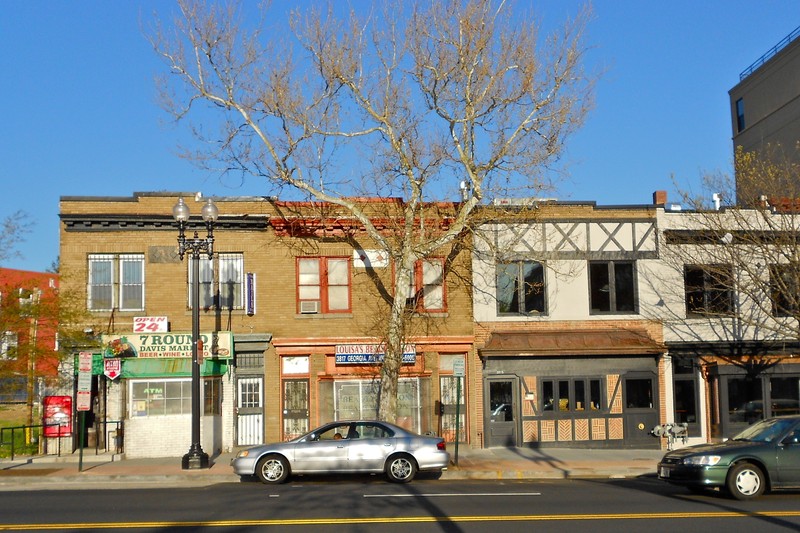Billy Simpson's House of Seafood and Steaks Site
Introduction
Text-to-speech Audio
Images
Billy Simpson's House of Seafood and Steak (third from left) by Smallbones on Wikimedia Commons (CC0)

Backstory and Context
Text-to-speech Audio
William W. "Billy" Simpson (1914-1975) opened Billy Simpson's House of Seafood and Steaks in 1956, filling a need for fine dining that catered to the African-American community. The dining room on the first floor of Billy Simpson's was paneled in knotty pine, with terrazzo floors. Upstairs was the Ebony Table lounge, an exclusive part of the restaurant which featured the Gold Coast Bar, decorated with an illuminated map of Africa on the ceiling and a mirrored wall. The kitchen was on the first floor.
The restaurant became a hub of activity for Black politicians and public figures. Simpson led an informal group, called the "Round Table" or "Billy's Friends," which gathered in the Ebony Table lounge for political and social discussions and planning. African diplomats, less welcome in the capital's white establishments, also frequented the restaurant. Simpson supported the March on Washington for Jobs and Freedom, the Poor People's Campaign, and the anti-war movement, ending discrimination in hiring, and federal aid to minority-owned businesses. The restaurant was central to the development of the Black political class in Washington in the 1960s.
During the restaurant's occupancy of the building, its exterior appearance changed, with a stucco, brick, and false half-timber front replacing the original storefront and giving it a faux Tudor appearance. Windows resembling leaded glass added to this effect. The building had been constructed as one of four structures in a row in 1923 as a speculation by real estate investor Walter A. Dunigan, apparently without a registered architect. The original buildings had tan-colored brick facing and stepped parapets on flat roofs. The first business to occupy the building at 3815 Georgia Avenue was the bakery of Eugene Francois Minoux, a French immigrant. It was briefly the home of a cabinetmaking business before Russian Jewish immigrant Aaron Kushner and his sister Esther expanded the restaurant they owned next door into this space in 1935. A fire in 1947 to the 3815 Georgia Avenue building led to renovations, as did necessary up grades to plumbing and mechanical systems over the years. Several additions from the first half of the twentieth century expand into the lot behind the row. The Kushners sold the building to Billy Simpson in 1956.
After Simpson's death in 1975, his widow Edith continued to run the restaurant for several years before closing it. Beginning in the 1980s, several successive Caribbean restaurants operated in the space, including The Kaieteur. The Department of Housing and Community Development purchased the building in 2002. The D.C. Inventory of Historic Sites recognized the building as a historic landmark in 2008 and the National Register of Historic Places recognized it the following year. Before opening in 2012, a restaurant called Chez Billy significantly renovated the interior and exterior of the building. The site has continued to be home to neighborhood restaurants. Historical markers note the site of the former community hub.
Sources
Jones, Timothy A., Timothy J. Denee, and Kim Williams. Billy Simpson's House of Seafood and Steaks, National Register of Historic Places Inventory, National Archives. October 8th 2008. Accessed October 10th 2020. https://catalog.archives.gov/id/117692472.
Cultural Tourism DC. Billy Simpson's House of Seafood and Steaks Site, African-American Heritage Trail. Accessed October 10th 2020. https://www.culturaltourismdc.org/portal/billy-simpson-s-house-of-seafood-and-steaks-site-african-american-heritage-trail.
Silverman, Dan (Prince of Petworth). Holy Cow – Chez Billy’s Exterior Looking Sweet in Petworth, PoPville. November 21st 2011. Accessed October 13th 2020. https://www.popville.com/2011/11/holy-cow-chez-billys-is-looking-sweet-in-petworth/.
Spiegel, Anna. The Hilton Brothers Close Chez Billy Petworth to Make Way for a New Concept, Washingtonian. August 1st 2016. Accessed October 13th 2020. https://www.washingtonian.com/2016/08/01/chez-billy-petworth-closed-for-a-new-hilton-brothers-concept/.
https://commons.wikimedia.org/wiki/File:Billy_Simpson_DC_3rd_from_left.JPG
